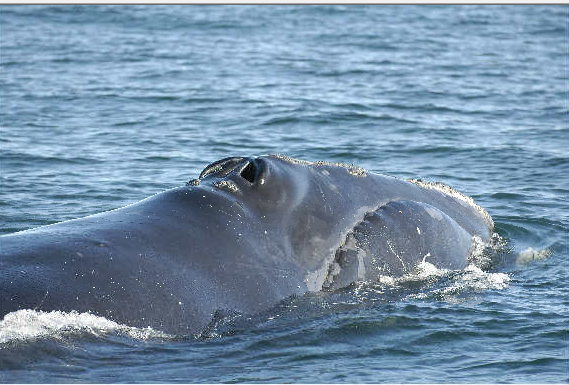
BOSTON, MASS. (April 4, 2024) – A North Atlantic right whale mother that was found dead off the Virginia coast last week died from a vessel strike, the National Oceanic and Atmospheric Administration (NOAA) announced Thursday. This is the third right whale to die by vessel strike in 2024, another significant loss for the critically endangered species that numbers less than 360 individuals.
The carcass of Catalog #1950 was found 50 miles off the coast of Virginia on March 30. It was towed ashore, and a necropsy was conducted on April 2. According to NOAA, preliminary findings indicated “catastrophic injuries with a complete dislocation of the whale’s spine and fractures to all vertebrae in the lower back.” The injuries are consistent with blunt force trauma from a vessel strike prior to the whale’s death.
Catalog #1950, who was at least 35 years old, had recently given birth to her sixth known calf, first seen together on January 11, 2024, by Clearwater Marine Aquarium’s Georgia aerial survey team. (More on the New England Aquarium’s calving season blog.) The calf, which aerial survey teams have been unable to locate, is not expected to survive without its mother.
“The death of a right whale mother, and the expected death of her young calf, is another tremendous loss for a species that is heading toward extinction. The high level of right whale mortality from human activities, especially females, is greatly reducing the chances for the recovery of this critically endangered species,” said Philip Hamilton, senior scientist in the Anderson Cabot Center for Ocean Life at the New England Aquarium.

To reduce the risk of vessel strikes, the National Oceanic and Atmospheric Administration (NOAA) has proposed modifications to the existing vessel speed rule. The proposed changes include both an expansion in time and space of seasonal speed zones; extending restrictions to include most vessels measuring 35 feet to 65 feet in length; and implementing mandatory, instead of voluntary, speed restrictions in dynamic speed zones, which are established when and where right whales are observed and are likely to remain. The proposed rule was published more than 18 months ago, and the final rule is now under interagency regulatory review.
“The delay of these protection measures has put this critically endangered species at continued risk from vessel strikes. We need to immediately implement speed restrictions in larger areas that cover important whale habitats if North Atlantic right whales are to have a chance at survival,” said Dr. Jessica Redfern, associate vice president of ocean conservation science at the Aquarium’s Anderson Cabot Center. Dr. Redfern led recently published research showing the benefits of vessel speed restrictions when it comes to protecting large whales.
This has been a challenging year for the right whales, with four documented deaths in three months. On January 28, a three-year-old female right whale entangled in fishing gear washed ashore dead on Martha’s Vineyard. Just a few weeks later, NOAA announced that a one-year-old female yearling found off Savannah, Georgia died of blunt force trauma, as evidenced by skull fractures consistent with a vessel strike. Then in early March, the eighth calf of 38-year-old right whale mother “Juno” (Catalog #1612) washed up dead on the Cumberland Island National Seashore in Georgia, after being seen with severe propeller wounds to its head, mouth, and lip earlier in the year. Three newborn calves this season have also disappeared.
MEDIA CONTACT: Pam Bechtold Snyder, psnyder@neaq.org; 617-686-5068
